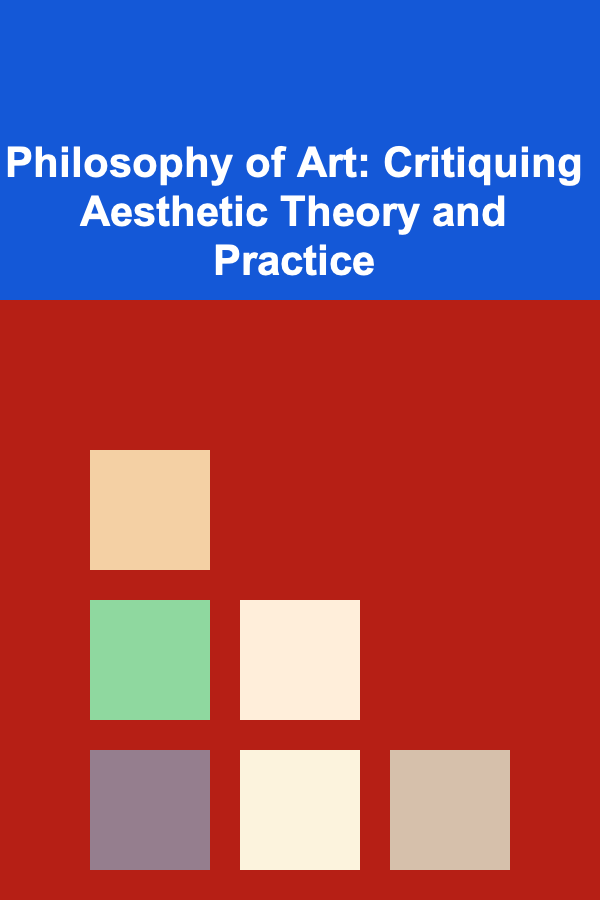
Philosophy of Art: Critiquing Aesthetic Theory and Practice
ebook include PDF & Audio bundle (Micro Guide)
$12.99$10.99
Limited Time Offer! Order within the next:

The philosophy of art has long been a domain of deep reflection, questioning the nature of art, its purpose, its significance, and its relation to human experience. Over the centuries, many thinkers and artists have attempted to define art and establish its value, with various schools of thought arising to critique and offer alternative perspectives on aesthetic theory and practice. This article delves into the fundamental issues in the philosophy of art, critiquing both aesthetic theory and practice, while engaging with critical perspectives from different philosophical traditions.
Understanding Aesthetic Theory
Aesthetic theory concerns itself with the study of beauty, taste, and the nature of artistic experience. Central to this field are questions such as: What is art? What makes something beautiful? What is the role of the artist? How do viewers engage with art, and how does it affect them? While these questions may seem straightforward, their answers are far from simple. Many philosophers have approached these questions through different lenses, from classical ideas of beauty to postmodern critiques of art's role in society.
Classical Conceptions: Beauty and Form
The earliest formal theories of art are rooted in ancient philosophy, particularly in the works of Plato and Aristotle. For Plato, art was seen as an imitation of nature --- a mimesis of the ideal forms that exist beyond the material world. Art, in this view, is merely a shadow or copy of the real world. Plato's skepticism toward art can be traced to his belief that art, being an imitation of reality, distorts truth and thus is far removed from the philosophical search for genuine knowledge.
In contrast, Aristotle took a more appreciative approach to art. In his Poetics, he argued that art, particularly tragedy, had the potential to elevate human understanding through catharsis --- the emotional purging that occurs when a viewer witnesses a powerful narrative. For Aristotle, art's ability to convey universal truths through the lens of individual human experiences made it valuable.
Both Plato and Aristotle, however, based their understanding of art on the idea that it had a higher, intellectual purpose, often tied to the pursuit of truth. This idealistic view of art, as a tool for exploring and representing truth and beauty, has remained influential throughout history.
Aestheticism and the Autonomy of Art
The 19th century saw the rise of aestheticism, epitomized by thinkers like Immanuel Kant and Oscar Wilde. For Kant, the experience of beauty was tied to what he called the sublime --- an aesthetic experience that transcends mere sensory pleasure and brings about a deeper, almost spiritual engagement with art. According to Kant, the aesthetic experience of beauty is autonomous, meaning that it does not serve any practical function or goal but exists purely for the sake of pleasure.
This notion of autonomy also had significant consequences for the practice of art. With the development of modernism in the 20th century, artists increasingly embraced the idea that art should exist for its own sake, independent of any moral, political, or social obligation. This notion challenged traditional views of art as serving a higher purpose and allowed for new forms of expression, often experimenting with abstraction, ambiguity, and individual interpretation.
The Evolution of Aesthetic Theory: From Modernism to Postmodernism
Modernism in art is often associated with the rejection of traditional forms, values, and conventions. The modernist movement, beginning in the late 19th and early 20th centuries, saw artists such as Picasso, Kandinsky, and Duchamp break with classical forms of representation and explore new methods of creating art. These artists sought to create works that questioned traditional concepts of beauty, representation, and the role of the artist in society.
However, modernist ideas of art were eventually critiqued by the postmodern movement, which emerged in the mid-20th century. Postmodernism questioned the idea that there could be a universal or objective understanding of art. Instead, postmodern theorists such as Jean-François Lyotard, Jacques Derrida, and Michel Foucault argued that art is inherently subjective and socially constructed. Postmodern art challenges the notion of a fixed meaning and embraces ambiguity, multiplicity, and the deconstruction of traditional narratives.
One of the key insights of postmodern thought is the idea that art is not just about personal expression or aesthetic beauty, but about the social and political context in which it is created and interpreted. Art becomes a tool for questioning dominant ideologies and deconstructing established power structures. As a result, the postmodern critique of art encourages viewers to be skeptical of claims of universal or timeless aesthetic values.
Critiquing Aesthetic Practice: From Creation to Reception
While aesthetic theory provides a framework for understanding art, aesthetic practice refers to the actual creation, interpretation, and appreciation of works of art. The relationship between theory and practice is central to the critique of art: how do the ideas that shape art reflect or distort the lived experience of artists and audiences?
The Artist's Role and Intentions
The role of the artist has been subject to shifting definitions throughout history. In classical and Renaissance art, the artist was often seen as a craftsman or technician whose job was to reproduce reality or represent divine truths. The modernist movement, however, introduced the artist as a more autonomous figure, one who was a genius or creator expressing individual vision.
Postmodern critiques, however, have raised questions about the artist's authority and the idea of artistic originality. Some theorists argue that the notion of the "genius artist" is a construct that reinforces elitist ideologies, suggesting that all art is collaborative and shaped by cultural, social, and historical forces. This view challenges the idea that the artist's intentions are paramount in understanding the meaning of a work.
The Viewer's Role and the Interpretation of Art
The viewer's role in the interpretation of art is also crucial to the philosophical critique of art. In classical aesthetic theory, the experience of beauty was seen as universal --- anyone who could appreciate the formal qualities of a work would arrive at a similar aesthetic judgment. This view has been critiqued by postmodern theorists, who argue that interpretations of art are shaped by the viewer's cultural, social, and historical context.
Theorists such as Hans-Georg Gadamer and Stanley Fish have argued that meaning in art is not fixed but is co-constructed by the viewer in the act of interpretation. Art, in this view, becomes a dynamic and evolving conversation between the artist, the work, and the audience. This shift away from the idea of objective meaning allows for greater diversity in interpretation but also raises questions about the limits of subjectivity in art appreciation.
Art and Politics: The Ethical Dimension
Art's relationship to politics is a contentious issue in aesthetic theory. Throughout history, art has been a vehicle for political expression, whether in the form of propaganda, social critique, or resistance. From the Russian avant-garde movements to protest art in the 20th century, artists have often used their work to comment on social issues and influence political change.
However, the ethical dimension of art has also been a subject of critique. Some argue that art should remain autonomous, detached from political agendas, while others contend that art is inherently political and cannot be separated from the social and historical contexts in which it is produced. The ethical critique of art asks whether art has a responsibility to address issues of justice, inequality, and human rights, or whether it should simply remain a form of personal or aesthetic expression.
Contemporary Critiques and Future Directions
The philosophy of art is ever-evolving, and contemporary critiques of aesthetic theory and practice continue to question and challenge traditional assumptions. Postcolonial theory, feminist theory, and critical race theory have all offered fresh perspectives on the role of art in society.
For example, postcolonial theorists have examined how Western art has historically marginalized or misrepresented non-Western cultures, and how art can be used to resist colonial narratives and express alternative histories. Feminist theorists have critiqued the gendered dimensions of art, from the exclusion of women from the artistic canon to the ways in which women artists have been historically overlooked or undervalued. Critical race theorists have similarly interrogated the ways in which race, power, and identity shape both the creation and reception of art.
As we look toward the future of the philosophy of art, it seems likely that the conversation will continue to shift toward more inclusive, intersectional, and socially engaged approaches. The boundaries of what constitutes art are constantly expanding, and the definition of aesthetic value is becoming increasingly pluralistic.
Conclusion
The philosophy of art is a rich and complex field, with a long history of debate and critique. Whether examining the relationship between beauty and truth, the autonomy of the artist, or the social function of art, philosophers continue to wrestle with questions about the nature, purpose, and value of art. At the same time, the practice of art remains an ever-changing field, shaped by cultural, political, and personal forces. By critiquing both the theories and the practices that define art, we gain a deeper understanding of its role in human experience and its power to shape society.

How to Organize Gift Wrapping Supplies in One Place
Read More
How to Use AliExpress for Dropshipping: Pros, Cons, and Alternatives
Read More
How to Use Options Trading to Boost Your Investment Strategy
Read More
How To Explore Quantum Computing for Manufacturing Optimization
Read More
10 Tips for Building a Strong Tennis Backhand
Read More
10 Tips for Gift Tags with Pressed Flowers
Read MoreOther Products

How to Organize Gift Wrapping Supplies in One Place
Read More
How to Use AliExpress for Dropshipping: Pros, Cons, and Alternatives
Read More
How to Use Options Trading to Boost Your Investment Strategy
Read More
How To Explore Quantum Computing for Manufacturing Optimization
Read More
10 Tips for Building a Strong Tennis Backhand
Read More